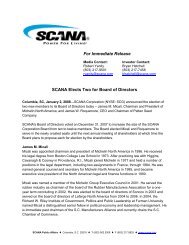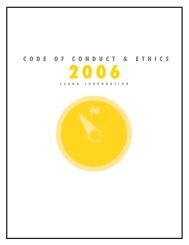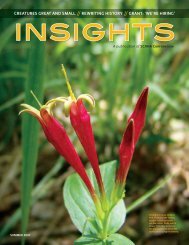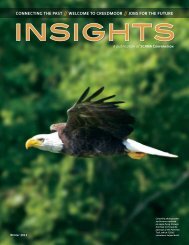SCE&G presents a view from Riverbanks Zoo - SCANA Corporation
SCE&G presents a view from Riverbanks Zoo - SCANA Corporation
SCE&G presents a view from Riverbanks Zoo - SCANA Corporation
Create successful ePaper yourself
Turn your PDF publications into a flip-book with our unique Google optimized e-Paper software.
SCE&G <strong>presents</strong><br />
a <strong>view</strong> <strong>from</strong><br />
<strong>Riverbanks</strong> <strong>Zoo</strong>
F R O M T H E C H A I R M A N<br />
Dear Customers and Friends:<br />
We’re pleased to announce<br />
that Kevin Marsh has been<br />
named the new president of<br />
South Carolina Electric & Gas.<br />
He previously served as<br />
<strong>SCANA</strong>’s chief financial officer.<br />
Marsh is a tremendous asset<br />
to our organization and an<br />
excellent choice to lead our<br />
largest subsidiary.<br />
In addition to his extensive<br />
financial background, he led<br />
PSNC Energy for two years,<br />
gaining valuable operations<br />
experience. You can get to know<br />
him in this issue of Insights.<br />
In another positive<br />
development, one of our largest<br />
industrial customers, Kimberly-<br />
Clark of Beech Island, S.C., is in<br />
the midst of two major<br />
expansions that will make this<br />
plant the company’s largest<br />
manufacturing facility in North<br />
America.<br />
Upon completion of the<br />
expansions next summer,<br />
Kimberly-Clark will employ<br />
approximately 1,750 with plant<br />
facilities exceeding three million<br />
square feet.<br />
We have worked closely with<br />
this company to ensure a<br />
reliable electric supply to<br />
accommodate the new load,<br />
including construction of a new<br />
substation on the Kimberly-<br />
Clark property. Insights was<br />
invited to visit this customer<br />
and share the experience with<br />
our readers.<br />
On a lighter note, you may<br />
want to share with friends and<br />
family who have small children<br />
a unique learning opportunity<br />
with <strong>Riverbanks</strong> <strong>Zoo</strong> in<br />
Columbia.<br />
Of course, you can’t beat a<br />
trip to see the zoo animals in<br />
person, but if the summer heat<br />
is too much or the drive is too<br />
far, you can now tune into live<br />
video feed through our Web<br />
site.<br />
SCE&G is proudly<br />
sponsoring what we call the<br />
“<strong>Zoo</strong>View,” broadcast across<br />
our fiber optic cable and<br />
<strong>view</strong>able at your computer<br />
<strong>from</strong> scegzoo<strong>view</strong>.com or<br />
riverbanks.org.<br />
The <strong>Zoo</strong>View has received<br />
national recognition. We hope<br />
you will enjoy using it. It is a<br />
great educational tool to help<br />
children learn more about the<br />
animal world.<br />
At <strong>SCANA</strong>, we’re committed<br />
to helping our communities and<br />
W.B. TIMMERMAN<br />
providing educational<br />
opportunities just as we are<br />
dedicated to providing you<br />
with safe, reliable energy<br />
service in the sweltering days of<br />
summer.
T A B L E O F C O N T E N T S<br />
Learning the ropes 2<br />
Meet SCE&G’s new president, Kevin Marsh, as he shares<br />
the experiences that have shaped his life and career<br />
An inside <strong>view</strong> 8<br />
SCE&G joins with <strong>Riverbanks</strong> <strong>Zoo</strong> in Columbia, S.C.<br />
to provide live video feed of zoo animals via the Internet<br />
Putting Beech Island on the map 14<br />
The current expansions at Kimberly-Clark in Beech Island<br />
will make the plant the company’s largest in North America<br />
A place in history 20<br />
Congressman James Clyburn and his wife have created an<br />
endowment to preserve the history of S.C. State University<br />
Rockin’ robots 24<br />
Keenan High School students were winners in a robotics<br />
competition created to promote math and science skills<br />
Summer 2006<br />
Volume 19, Number 2<br />
Editor<br />
Mary Green Brush<br />
Marketing Communications<br />
Director<br />
Cathy Love<br />
Senior Vice President of<br />
Marketing and<br />
Communications<br />
Sharon Jenkins<br />
<strong>SCANA</strong> Insights is produced<br />
quarterly by the <strong>SCANA</strong><br />
Public Affairs Dept. <strong>SCANA</strong><br />
Corp. is a $9 billion energybased<br />
holding company with<br />
subsidiaries providing<br />
electric, natural gas and<br />
telecommunications services.<br />
Call 803-217-8833 if you have<br />
any comments, questions or<br />
ideas for articles or e-mail<br />
mgbrush@scana.com.<br />
NewsScan 28<br />
◆ Customers get “extreme makeovers” with weatherization<br />
◆ Lake Murray Backup Dam wins national recognition<br />
<strong>SCANA</strong> Insights can be<br />
<strong>view</strong>ed on the <strong>SCANA</strong> Home<br />
Page at www.scana.com.<br />
Mail Code 063<br />
<strong>SCANA</strong> Corp.<br />
Columbia, SC 29218<br />
Cover: The Gentoo Penguins, one of the latest additions to<br />
<strong>Riverbanks</strong> <strong>Zoo</strong> and Garden, are native to subantarctic<br />
islands. The penguins, located at the zoo’s birdhouse, can<br />
swim up to 20 miles per hour. They can be seen by webcam at<br />
scegzoo<strong>view</strong>.com.<br />
PHOTO BY ROBERT CLARK<br />
© 2006 <strong>SCANA</strong> <strong>Corporation</strong>.<br />
All rights reserved.<br />
Printed on recycled paper
New SCE&G President<br />
Kevin Marsh visits<br />
McMeekin Station near Lake<br />
Murray, meeting with<br />
employees and touring the<br />
facilities.<br />
learning<br />
the ropes<br />
New SCE&G president<br />
takes the helm<br />
2 <strong>SCANA</strong> Insights
In 1967, Archie Bell and the Drells recorded the hit song “Tighten Up,” which<br />
inspired a bit of a dance craze in the late ‘60s. Soon after, the tune became the<br />
opening number for a high school cover band <strong>from</strong> Athens, Ga. On drums —<br />
outfitted in a green ruffled satin shirt, white pants and shimmering white<br />
Corfam ® shoes (with tassels) — was a young preacher’s son named Kevin Marsh.<br />
Marsh, who in May succeeded Neville Lorick as president and chief operating<br />
officer of SCE&G, recalls fondly his turn as a play-for-pay musician. But he’d<br />
prefer to forget the ruffles and tassels. “Obnoxious,” he says of the band’s<br />
outfits. “I mean, they were horrible.”<br />
Summer 2006 3
These days, you’re more<br />
likely to find Marsh dressed in<br />
business casual as he immerses<br />
himself in the responsibilities of<br />
his new job. He still likes to<br />
bang the skins <strong>from</strong> time to<br />
time, though. “Most people<br />
probably wouldn’t know that I<br />
play the drums, and that I like<br />
the hard rock stuff,” he said,<br />
smiling. “I have a drum set<br />
upstairs in my house. It’s a<br />
great stress reliever.”<br />
Now in his 22nd year with<br />
<strong>SCANA</strong>, Marsh stepped into his<br />
newest role after a decade as<br />
<strong>SCANA</strong>’s chief financial officer.<br />
But this isn’t his first foray into<br />
the operations arena.<br />
From October 2001 to March<br />
2003, he served as president<br />
and chief operating officer of<br />
PSNC Energy, <strong>SCANA</strong>’s natural<br />
gas distribution company in<br />
Gastonia, N.C., in addition to<br />
his CFO duties.<br />
In pointing out differences<br />
between the operational and<br />
financial sides of the business,<br />
Marsh drew on his passion for<br />
automobiles for an analogy.<br />
“One thing I like about auto<br />
racing is that when a race starts,<br />
it continues until it’s over,” he<br />
said. “There is no time-out. In<br />
the operations area, especially<br />
in the business we’re in, there<br />
are no time-outs.<br />
“In gas, service has got to be<br />
delivered; pressure has to stay<br />
in the lines the whole time or<br />
the pilot lights go out. On the<br />
electric side, if the generation<br />
plants aren’t working or the<br />
lines aren’t in service, the lights<br />
go out.<br />
“Our customer service reps<br />
are always working to respond<br />
to the needs of our customers.<br />
The whole loop of delivering<br />
service never stops. Seeing and<br />
understanding what it takes for<br />
all that to happen is a real<br />
different experience as opposed<br />
to selling bonds or pricing<br />
stock.”<br />
Marsh’s business<br />
perspectives, as well as his<br />
interest in cars and motor<br />
sports, are rooted in his<br />
childhood and the example set<br />
by his grandfather – Marsh<br />
affectionately refers to him as<br />
“Boppy” – who immigrated to<br />
the United States <strong>from</strong> Lebanon<br />
with his family in 1900.<br />
“He was the sole proprietor<br />
of an automobile repair shop,”<br />
said Marsh. “Watching the way<br />
he treated his customers had a<br />
big impact on the way I treat<br />
people. Watching his<br />
compassion and way of<br />
working with everyone who<br />
came in there really left an<br />
impression on me.<br />
“I would spend my summers<br />
with him, working on cars in<br />
his shop. That’s where I got my<br />
love for cars and auto sports.<br />
Watching the way he ran his<br />
business and the way he treated<br />
people – I’ve never forgotten<br />
that. He was a tremendous<br />
influence on me.”<br />
Marsh still pays tribute to<br />
that influence. Hanging on the<br />
wall next to his desk is a framed<br />
copy of the diploma his<br />
grandfather earned <strong>from</strong> a<br />
4<br />
<strong>SCANA</strong> Insights
Kansas City mechanic’s school<br />
in 1923, along with a photo of<br />
the graduating class. “I know<br />
he was a proud man because<br />
he’s the only one in the photo<br />
with a tie on,” said Marsh,<br />
smiling.<br />
Born in Atlanta, Marsh and<br />
his family moved around a bit<br />
as his father pursued a<br />
ministerial career. After stops in<br />
Ft. Myers, Fla. and Sewanee,<br />
Tenn., the family eventually<br />
settled in Athens, Ga. when<br />
Marsh’s father took a post in<br />
1965 as the Episcopal chaplain<br />
at the University of Georgia.<br />
Marsh would remain in<br />
Athens until graduating <strong>from</strong><br />
the University of Georgia with<br />
an accounting degree in 1977.<br />
During his somewhat<br />
transient youth, Marsh attended<br />
eight different schools in 11<br />
years; he actually skipped a<br />
grade so he could graduate the<br />
same time as his girlfriend, who<br />
was a year ahead of him.<br />
Marsh was in eighth grade,<br />
Sue was in ninth, when they<br />
were introduced by friends at<br />
an intramural volleyball game<br />
in which his older brother was<br />
playing. They celebrated their<br />
30th wedding anniversary last<br />
year.<br />
Among his proudest<br />
accomplishments, Marsh counts<br />
the “two great daughters” he<br />
and Sue raised together.<br />
“My wife probably deserves<br />
most of the credit,” he said.<br />
“But I believe setting an<br />
example for them in the way I<br />
conduct business has probably<br />
had an impact on them. Both of<br />
my kids are out of the house,<br />
finding their way. That’s<br />
rewarding. I look at that as a<br />
personal accomplishment.”<br />
Growing up as sons of a<br />
minister, Marsh said he and his<br />
brother were taught the<br />
importance of values early on.<br />
That didn’t mean, though, that<br />
the boys wore halos. “We were<br />
mischievous kids,” said Marsh<br />
with a sly smile.<br />
“I’ve sat down a couple<br />
times and started to write a<br />
book about my brother and me.<br />
We’ve had a million experiences.<br />
“If you’ve seen that movie,<br />
‘The Sandlot’ – I could write<br />
that story about me and my<br />
brother. I’ve written the first<br />
page; the first line in the book is<br />
‘We were preacher’s kids.’ My<br />
brother and I knew very clearly<br />
what was right and what was<br />
wrong and where you drew the<br />
line. As I look back on the<br />
things we did, I don’t think we<br />
ever did anything that was<br />
wrong, but, buddy, did we ride<br />
right up to that line plenty of<br />
times.”<br />
Two years into his schooling<br />
at the University of Georgia,<br />
Marsh was still undecided<br />
about his career path. Then an<br />
accounting professor who was<br />
close friends with Marsh’s<br />
father suggested that Marsh try<br />
some accounting classes. “I fell<br />
in love with it,” he said. “I had<br />
a real knack for it.”<br />
Upon graduating, Marsh<br />
accepted a position with<br />
Deloitte & Touche, an<br />
Summer 2006 5
accounting firm in Columbia,<br />
S.C. <strong>SCANA</strong> was one of the<br />
accounts he worked on. In 1984,<br />
he was invited to join the<br />
company. He’s never looked<br />
back.<br />
Now, as president of<br />
<strong>SCANA</strong>’s principal subsidiary,<br />
Marsh said he feels blessed to<br />
be taking the helm of an<br />
organization that is already on a<br />
positive course.<br />
“I use the example of a ship,”<br />
he said. “I feel like my goal is to<br />
keep a firm hand on the rudder<br />
and do my part to keep the<br />
wind in the sails – not to turn<br />
the ship around, because it’s<br />
headed in the right direction.<br />
That’s a fortunate position to be<br />
in.”<br />
Marsh credits that good<br />
fortune, in part, to the<br />
leadership and “impeccable<br />
values” that his predecessor,<br />
Neville, demonstrated in<br />
running the company.<br />
“He never compromised his<br />
values to make a job simple,”<br />
said Marsh. “It motivates you to<br />
do the same thing. I’ve seen the<br />
way Neville works and cares<br />
about people, and that rubs off<br />
on you.”<br />
Marsh said his vision for<br />
SCE&G is twofold. “One, we<br />
need to provide safe, reliable<br />
service to customers at a<br />
reasonable cost. That’s what<br />
we’re here to do. That’s our<br />
mission as a company,” he said.<br />
“Secondly, I want us to be able<br />
to do that without sacrificing<br />
our values and by doing the<br />
right things.”<br />
With hurricane season<br />
having kicked off just two<br />
weeks into his presidency,<br />
Marsh is making an immediate<br />
priority of ensuring that<br />
SCE&G is ready to implement<br />
its storm response plans.<br />
“We have a great storm plan,<br />
but we’ve not been tested like<br />
we were in 1989 with Hurricane<br />
Hugo,” he said. “We hope we<br />
don’t have to test ourselves like<br />
that again, but I believe our<br />
people are ready. Making sure<br />
we are ready to respond, and<br />
understanding my role in that<br />
process, is something I’ve put a<br />
priority on.”<br />
Marsh said he’s also focused<br />
on understanding and<br />
responding to the concerns of<br />
employees and working to help<br />
solve problems to the best of his<br />
ability.<br />
“I can’t always solve them<br />
the way people want me to<br />
solve them,” he said, “but I’ve<br />
always been willing to listen.<br />
Let me understand the issue,<br />
and let’s see if we can address<br />
it.”<br />
Honesty, dedication and<br />
commitment to <strong>SCANA</strong>’s<br />
values are qualities Marsh said<br />
are consistently demonstrated<br />
by employees of the company.<br />
“I always see our people<br />
ready to step up,” he said.<br />
“They’re ready to do the right<br />
thing.”<br />
Such positive attitudes, he<br />
said, are an important part of<br />
<strong>SCANA</strong>’s unique culture.<br />
“You hear the term ‘<strong>SCANA</strong><br />
family,’ and I think it really is<br />
like a family. I remember one<br />
officer who joined our company<br />
a number of years ago made the<br />
comment, ‘These people are<br />
really friendly.’ I said, ‘Yeah,<br />
what’s so unusual about that?’<br />
He said, ‘They mean it ...<br />
They’re sincere!’ I said, ‘Sure,<br />
that’s how we are.’”<br />
BY ERIC BOOMHOWER<br />
PHOTOS BY JEFF AMBERG<br />
6<br />
<strong>SCANA</strong> Insights
Favorite food: Steak or hamburger. “I’m a<br />
meat and potatoes guy.”<br />
Favorite time of year: Autumn. “I love<br />
the crispness in the air.”<br />
Favorite movie: Hoosiers.<br />
Favorite way to spend a Saturday<br />
afternoon: Taking his wife in their 1967<br />
Austin Healey 3000 convertible to get<br />
some BBQ.<br />
First car: A Triumph Herald. “I paid $250<br />
for it when I was 13.”<br />
Most exciting experience: Birth of his<br />
children. “Nothing can really compare to<br />
that.”<br />
What makes him smile: Humor. “I think<br />
humor has a definite place in the<br />
workplace, as long as it’s not taken to<br />
extremes.”<br />
What makes him frown: People who work<br />
outside established processes. “It’s<br />
counterproductive. It just kills so much<br />
momentum.”<br />
Summer 2006 7
Visitors to Columbia’s <strong>Riverbanks</strong> <strong>Zoo</strong> have long enjoyed watching the<br />
graceful gait of the giraffes, the self-assured swing of the siamangs and<br />
the playful pageantry of the penguins. Now, all of these <strong>view</strong>s and more<br />
are available around the globe thanks to the SCE&G <strong>Zoo</strong>View Webcam.<br />
With the webcam, observers have more opportunities to see the true<br />
nature of the animals, something that might be missed during a zoo<br />
visit, especially if the animal is sleeping or inactive.<br />
Early in 2005 the webcam was installed in the <strong>Zoo</strong>’s Koala Knockabout<br />
offering “ahh-inspiring” streaming video of the cuddly marsupials.<br />
SCE&G's <strong>Zoo</strong>View was perfectly suited for koalas because of their<br />
sporadic levels of activity and was ranked as one of the 2005 Top 25<br />
most interesting webcams in the world by earthcam.com.<br />
Since the average amount of time spent in front of a zoo exhibit by a<br />
visitor is less than 45 seconds, <strong>Zoo</strong>View offers a significantly more<br />
intimate observation<br />
of an animal's<br />
behavior. SCE&G and<br />
<strong>Riverbanks</strong> <strong>Zoo</strong><br />
have a long<br />
history together of<br />
cooperation and<br />
respect.<br />
AN INSIDE VIEW<br />
This latest venture<br />
together began when<br />
Sharon Jenkins,<br />
SCE&G’s senior vice<br />
president of marketing and communications, joined <strong>Riverbanks</strong> Society's Board of<br />
Directors and saw the potential of another partnership.
photo by Robert Clark<br />
3
<strong>SCANA</strong>, through its<br />
telecommunications business,<br />
owns and operates a high<br />
capacity, fiber optics network in<br />
South Carolina, North Carolina<br />
and Georgia.<br />
Since the network, capable of<br />
carrying millions of telephone<br />
conversations and data at one<br />
time, is located in the vicinity of<br />
the zoo, the company was able<br />
to expand the line directly into<br />
the zoo and broadcast <strong>Zoo</strong>View<br />
images through live video<br />
feeds.<br />
Concerning the <strong>Zoo</strong>View’s<br />
impact, Jenkins said, “The<br />
SCE&G <strong>Zoo</strong>View project is<br />
representative of SCE&G’s<br />
ongoing commitment to<br />
education and community<br />
service.<br />
“We love that this gives<br />
people who either can’t get to<br />
the zoo or want to experience<br />
the zoo <strong>from</strong> the convenience of<br />
their own desktop the<br />
‘<br />
July 6, 2006 - White Alligator<br />
Aug. 3, 2006 - Amur Tigers<br />
Sept. 7, 2006 - African Lions<br />
Oct. 5, 2006 - Grizzly Bears<br />
Nov. 2, 2006 - Sea Lions<br />
Dec. 7, 2006 - Gorillas<br />
Jan. 4, 2007 - Meerkats<br />
Feb. 8, 2007 - African Elephants<br />
SCE&G <strong>Zoo</strong>View<br />
tentative schedule<br />
opportunity to invite some of<br />
the world’s most treasured<br />
animals into their homes.”<br />
In an effort to showcase more<br />
of the creatures of <strong>Riverbanks</strong>,<br />
the decision was made in May<br />
2006 to move the webcam each<br />
month and highlight different<br />
exhibits in the park.<br />
“The next 12 months should<br />
be eye-opening, to say the<br />
least,” said Satch Krantz,<br />
<strong>Riverbanks</strong> <strong>Zoo</strong> and Garden’s<br />
executive director. “We’re<br />
excited about this camera<br />
giving guests a unique <strong>view</strong> of<br />
the zoo.”<br />
As SCE&G’s <strong>Zoo</strong>View moves<br />
throughout the park, <strong>view</strong>ers<br />
are treated to unique<br />
perspectives of the exhibits as<br />
keepers tend to their animals,<br />
with most cameras running<br />
7 a.m. to 7 p.m.<br />
During July the focus is on a<br />
rare, white alligator whose<br />
story is nearly as fascinating as<br />
March 8, 2007 - Reticulated<br />
Giraffes<br />
April 5, 2007 - Koalas<br />
May 3, 2007 - Siamangs<br />
June 7, 2007 - Lorikeets<br />
Schedule subject to change. Visit<br />
www.scegzoo<strong>view</strong>.com for the latest<br />
information.<br />
his striking eyes. The alligator,<br />
which hatched in a Sea Pines<br />
Plantation lagoon on Hilton<br />
Head Island, has been cared for<br />
at the zoo’s Aquarium and<br />
Reptile Complex for the past<br />
two years. It is being held there<br />
for the S.C. Department of<br />
Natural Resources.<br />
The alligator, Alligator<br />
mississippiensis, is thought to be<br />
the only white alligator in the<br />
state.<br />
The animal is leucistic, a rare<br />
genetic mutation that causes a<br />
lack of color pigments in the<br />
skin, although unlike an albino,<br />
it has brown eyes and a brown<br />
patch on its head.<br />
White alligators rarely<br />
survive in the wild since they<br />
lack the camouflage necessary<br />
to protect themselves <strong>from</strong><br />
predators and to hunt prey.<br />
In October <strong>view</strong>ers will be<br />
treated to the antics of the<br />
young Grizzly Bears, Ursus<br />
arctos horribilus.<br />
Grizzlies are most active in<br />
the morning and early evening<br />
with long rests in the middle of<br />
the day. So, <strong>Zoo</strong>View will offer<br />
a supplemental benefit to a zoo<br />
visit if you miss the bears in<br />
action.<br />
And if you want to see more<br />
of your favorite animal when<br />
the camera moves on, just visit<br />
scegzoo<strong>view</strong>.com to <strong>view</strong> stored<br />
video.<br />
SCE&G is proud to provide a<br />
limitless <strong>Zoo</strong>View, offering not<br />
only entertainment but insight<br />
into animal behavior and<br />
husbandry reaching far beyond<br />
Columbia.<br />
BY MARY MARLOWE LEVERETTE<br />
photo by Robert Clark<br />
10<br />
<strong>SCANA</strong> Insights
It started with a tiger<br />
O. Stanley Smith in 1964 purchased a<br />
Bengal tiger cub and named her Happy to<br />
promote his Esso gas station and car wash<br />
and to fuel interest in the establishment of<br />
a Columbia-area zoo. Happy began her<br />
“zoo life” in specially built quarters at<br />
Constan Car Wash on Gervais Street,<br />
where she would remain for the next 10<br />
years.<br />
Simultaneously plans were announced<br />
by the Columbia <strong>Zoo</strong>logical Society for a<br />
fund-raising drive to finance the<br />
establishment of a children’s zoo. SCE&G,<br />
owner of the land at the confluence of the<br />
Broad and Saluda rivers, made 16 choice<br />
acres available to the society.<br />
While more than $65,000 was<br />
accumulated <strong>from</strong> that first fund drive,<br />
the project made little progress during the<br />
next three years as projected costs rose to<br />
$350,000.<br />
Then in 1967 a Richland-Lexington<br />
Joint Planning Committee recommended<br />
the development of some 100-plus acres<br />
spanning the Saluda River into a larger<br />
zoo and park. The management of SCE&G<br />
promptly agreed to a 99-year lease at the<br />
cost of $1 per year to help make the dream<br />
a reality.<br />
Even with SCE&G’s generosity it<br />
became clear to the society and local<br />
officials that governmental involvement<br />
was essential to the success of the project,<br />
and on July 11, 1969 the S.C. Secretary of<br />
State officially swore in the <strong>Riverbanks</strong><br />
Park Commission. John Mehrtens was<br />
chosen as the first director, and<br />
construction began in 1971.<br />
Mehrtens was a man of vision. He<br />
guided the architects and builders to<br />
construct exhibits with no bars or visible<br />
barriers, offering the animals and the<br />
visitors the most natural environments<br />
available at the time – much of which is<br />
still in use today. Construction was slow<br />
due to the new techniques and financial<br />
concerns, but the zoo plodded along,<br />
opening April 25, 1974 with Happy finally<br />
in residence.<br />
In the years since, <strong>Riverbanks</strong> <strong>Zoo</strong> and<br />
Garden has developed into one of<br />
America’s finest small zoos. The staff, led<br />
for the last 30 years by Executive Director<br />
Satch Krantz, has earned numerous<br />
awards for the breeding of endangered<br />
species, such as the Amur Tiger or<br />
Panthera tigris, in addition to horticulture<br />
and marketing.<br />
When <strong>Riverbanks</strong> Botanical Garden<br />
opened in June 1995, an additional 50<br />
acres of land with breathtaking river<br />
<strong>view</strong>s, granite outcroppings and the<br />
historic pre-Civil War era Saluda Mill<br />
became accessible to the public.<br />
Today, <strong>Riverbanks</strong> <strong>Zoo</strong> draws more<br />
than 850,000 visitors each year to the<br />
banks of the Saluda River and has twice<br />
been awarded the Governor’s Cup as the<br />
top attraction in South Carolina. It all<br />
began with a tiger, a dream and a<br />
generous, community-minded company.<br />
BY MARY MARLOWE LEVERETTE<br />
To extend the scope of the project<br />
to the widest number of <strong>view</strong>ers,<br />
SCE&G and <strong>Riverbanks</strong> have joined<br />
promotional partners WLTX-TV<br />
(Channel 19) and The State<br />
newspaper’s Newspapers in Education<br />
program to publicize the site.<br />
The State highlights the online<br />
animals each month in its<br />
Newspapers In Education section.<br />
WLTX-TV airs feature segments<br />
about each animal during its<br />
Thursday morning show and<br />
highlights the SCE&G <strong>Zoo</strong>View on its<br />
Web site.<br />
Photo courtesy of <strong>Riverbanks</strong> <strong>Zoo</strong><br />
12<br />
<strong>SCANA</strong> Insights
and a dream<br />
Summer 2006 137
Kimberly-Clark puts Beech Island<br />
on the map<br />
14<br />
<strong>SCANA</strong> Insights
When it comes to paper products giant Kimberly-Clark, think big.<br />
A current expansion at the company’s Beech Island, S.C. facility will make<br />
it Kimberly-Clark’s largest manufacturing facility in North America upon<br />
completion, with approximately 3 million square feet, a 50 percent<br />
increase in size. Employment will increase <strong>from</strong> 1,100 positions to 1,300,<br />
with an additional 450 temporary and contractor jobs. Energy<br />
consumption, too, will increase for one of SCE&G’s largest industrial<br />
customers.<br />
Sid Ballentine of<br />
SCE&G and Laura<br />
Dzamka of<br />
Kimberly-Clark<br />
examine giant rolls<br />
of tissue that are<br />
softened and cut<br />
into smaller rolls of<br />
Cottonelle ® toilet<br />
tissue.<br />
Summer 2006 15
State and community leaders<br />
were ecstatic last April when<br />
Kimberly-Clark officials<br />
announced plans to ramp up<br />
production of Huggies ® diapers<br />
and Pull-Ups ® training pants<br />
during a groundbreaking<br />
ceremony for a previously<br />
announced tissue<br />
manufacturing and packaging<br />
facility.<br />
That announcement meant<br />
the local community and South<br />
Carolina had even more to<br />
celebrate in terms of jobs and<br />
investment in new facilities.<br />
According to Mill Manager<br />
Tom Colgrove, the company is<br />
using economies of scale by<br />
moving toward fewer but larger<br />
production sites.<br />
For example, the popular<br />
Huggies ® brand of disposable<br />
diapers, currently being<br />
manufactured at five locations,<br />
will be produced at only three<br />
by the end of the next 12<br />
months.<br />
One of those locations is the<br />
Beech Island facility, where a<br />
200,000-square-foot addition is<br />
being built to handle the<br />
expansion of baby and child<br />
care products manufacturing.<br />
At the same time,<br />
construction is progressing on a<br />
900,000-square-foot building to<br />
house Kimberly-Clark’s stateof-the-art<br />
toilet tissue<br />
manufacturing process and a<br />
78,000-square-foot warehouse.<br />
The Beech Island facilities<br />
produce the following products:<br />
• Cottonelle ® and specialty<br />
brands of toilet tissue,<br />
• Kleenex ® facial tissue,<br />
• Moist wipes in a number of<br />
variations,<br />
• Huggies ® disposable diapers<br />
and Pull-Ups ® training pants.<br />
Kimberly-Clark built its first<br />
facility in South Carolina in<br />
1968 with two tissue machines,<br />
a couple of processing areas<br />
and warehouse space.<br />
The plant expanded in 1997<br />
to accommodate a state-of-theart<br />
toilet tissue manufacturing<br />
process. Current expansions are<br />
scheduled for completion by the<br />
summer of 2007.<br />
To meet the needs of what<br />
will become its largest North<br />
American manufacturing<br />
facility, Kimberly-Clark had<br />
three basic requirements,<br />
including:<br />
• An available work force<br />
• Affordable, reliable energy<br />
• A good business climate with<br />
support <strong>from</strong> local and state<br />
governments.<br />
Beech Island was a winner<br />
on all three fronts. Colgrove<br />
anticipates plenty of qualified<br />
applicants for the new positions<br />
that will become available. The<br />
company recently received<br />
1,000 applications to fill 17<br />
positions.<br />
“We have developed a track<br />
record of excellent results over<br />
38 years with very low<br />
turnover,” he said. “We are<br />
fortunate to have a good<br />
reputation in the community.<br />
We get a lot of applicants when<br />
we go to hire.”<br />
The Beech Island facility runs<br />
24 hours a day, seven days a<br />
week and must have reliable<br />
energy to do so.<br />
“Kimberly-Clark could have<br />
gone to other sites. One reason<br />
they chose this one is because<br />
we have cost efficient, reliable,<br />
high quality energy,” Colgrove<br />
said.<br />
“I’ve worked at a number of<br />
other locations. The reliability<br />
here is terrific. It’s better than<br />
any other locations where I<br />
16<br />
<strong>SCANA</strong> Insights
have worked. When we do<br />
have upsets such as severe<br />
electrical storms, we’ve been<br />
pleased with their<br />
responsiveness.”<br />
Electricity costs and<br />
utilization are monitored closely<br />
by Kimberly-Clark’s energy and<br />
environmental engineer, Laura<br />
Dzamka.<br />
She communicates regularly<br />
with Sid Ballentine, SCE&G’s<br />
large customer representative<br />
for Kimberly-Clark concerning<br />
all aspects of Kimberly-Clark’s<br />
electric service.<br />
In one instance, the customer<br />
was having a problem with<br />
lightning strikes damaging<br />
equipment inside the plant.<br />
“Sid helped us design a<br />
system that was more robust to<br />
address these problems,” she<br />
said. “We also have regular<br />
energy meetings on partnership<br />
opportunities with SCE&G.”<br />
At one time, SCE&G tried<br />
burning Kimberly-Clark diaper<br />
scraps as fuel at nearby<br />
Urquhart Station, but the mill<br />
could not supply enough to<br />
make the project feasible. With<br />
increased production, that<br />
project may become feasible in<br />
the future, Dzamka said.<br />
Kimberly-Clark is a good<br />
neighbor and a good steward of<br />
the environment with a bright<br />
future.<br />
The parent company recently<br />
earned top honors <strong>from</strong> the<br />
United Way of America for “its<br />
commitment to improve lives in<br />
local communities.” The South<br />
Carolina plant follows that<br />
same commitment, with local<br />
employees donating<br />
approximately $100,000 a year<br />
to the United Way and the<br />
company matching that<br />
donation.<br />
Tom Colgrove,<br />
manager of<br />
Kimberly-Clark’s<br />
Beech Island<br />
facilities, explains<br />
the factors that led<br />
the global paper<br />
products giant to<br />
make the South<br />
Carolina plant its<br />
largest<br />
manufacturing<br />
facility in North<br />
America. Behind<br />
him are products<br />
made at Beech<br />
Island.<br />
Summer 2006 17
In addition, plant employees<br />
volunteer with local schools to<br />
further science education.<br />
While tissue manufacturing<br />
requires large amounts of water,<br />
Colgrove proudly notes that<br />
design changes and new<br />
processes currently being<br />
implemented will reduce water<br />
consumption at the plant by 75<br />
percent.<br />
With its prominent role in a<br />
worldwide organization,<br />
Colgrove anticipates that the<br />
Beech Island facilities will<br />
eventually add more products<br />
to their manufacturing lines.<br />
Innovation is a major focus at<br />
Kimberly-Clark. “We’re very<br />
focused on our global business<br />
plan. Our goal is to expand the<br />
appeal of existing products and<br />
come up with new ones,” he<br />
said.<br />
Big expansion, big numbers<br />
880,000<br />
square feet of new building space<br />
Equivalent to: 21 acres<br />
18 football fields<br />
450 average houses<br />
1 million<br />
man-hours to construct<br />
75,000<br />
tons of gravel for roads, trailer parking, foundations<br />
400,000<br />
cubic yards of dirt hauled, all available on site<br />
Equivalent to: 41,000 dump truck loads<br />
A 24-story building the size of a football field<br />
500<br />
miles of wire<br />
Equivalent to: Driving <strong>from</strong> Augusta National<br />
to U.S. Golf Association Hall of Fame, St. Petersburg, Fla.<br />
38,000<br />
cubic yards of concrete<br />
Equivalent to: 4,200 concrete trucks<br />
130 miles of city sidewalk<br />
3,480<br />
Tons of building steel<br />
Equivalent to: 7 million pounds of steel<br />
2,500 Ford Mustangs<br />
18 <strong>SCANA</strong> Insights
With its 124-year history, the<br />
company has stayed on the<br />
cutting edge in its field, <strong>from</strong><br />
inventing paper towels in 1907<br />
and Kleenex ® in 1924, to<br />
advertising toilet tissue on<br />
national television for the first<br />
time in 1955 and<br />
revolutionizing baby care with<br />
Huggies ® , Pull-Ups ® training<br />
pants and Huggies ® disposal<br />
swimpants, more recently.<br />
With expansion in the works<br />
and new jobs on the horizon,<br />
Kimberly-Clark’s Beech Island<br />
facility is positioned to play an<br />
increasingly important part in<br />
the Wisconsin-based company<br />
and an equally important role<br />
as employer, taxpayer and<br />
corporate citizen in South<br />
Carolina.<br />
BY MARY GREEN BRUSH<br />
PHOTOS BY ROBERT CLARK<br />
SCE&G employees<br />
work on the new<br />
substation SCE&G<br />
built for Kimberly-<br />
Clark. In an<br />
extremely rare<br />
move, the plant had<br />
to turn off all<br />
power for three<br />
days to switch<br />
over.<br />
Summer 2006 19
A place in history<br />
Clyburn Endowment preserves history<br />
and legacy of S.C. State University<br />
S.C. State Dean of<br />
Library and<br />
Information<br />
Services Mary L.<br />
Smalls, at right,<br />
and Pearl Davis,<br />
administrative<br />
specialist, re<strong>view</strong><br />
historical<br />
documents.<br />
As a student at South<br />
Carolina State College in 1960,<br />
Sixth District Congressman Jim<br />
Clyburn and six other students<br />
<strong>from</strong> S.C. State and a<br />
neighboring institution<br />
organized the first sit-ins in<br />
South Carolina during the civil<br />
rights era.<br />
The seven students were<br />
inspired by four other African-<br />
American college students who<br />
organized the first sit-in at a<br />
Greensboro, N.C. Woolworth’s<br />
restaurant, seeking equal<br />
treatment and service as white<br />
customers.<br />
Those Greensboro students<br />
helped to form the Student<br />
Nonviolent Coordinating<br />
Committee (SNCC) to push<br />
along integration in many areas<br />
of the South.<br />
Clyburn and the classmates,<br />
whom he still refers to as “my<br />
family,” became early SNCC<br />
members. What they were<br />
doing was dangerous to both<br />
their physical safety and their<br />
academic future; 15 students<br />
were either expelled or<br />
suspended <strong>from</strong> S.C. State four<br />
years earlier for peaceful<br />
campus protests.<br />
But, Clyburn and the others<br />
persisted.<br />
“I had a sense that what we<br />
were doing was important,” he<br />
said. His career and life have<br />
been defined by that sense of<br />
obligation. If you ask him,<br />
however, about his most<br />
important, most lasting S.C.<br />
State memory, he will very<br />
quickly tell you that “it was the<br />
day in 1959 that I met my wife,<br />
Emily.”<br />
Following their graduation<br />
<strong>from</strong> S.C. State, the couple<br />
began their professional careers<br />
in the Charleston County public<br />
schools. Clyburn became a<br />
history teacher, and his wife<br />
became a librarian.<br />
Their experiences as students<br />
during a tumultuous time in<br />
history and their early<br />
professional backgrounds<br />
fostered their appreciation of<br />
history, and a love for their alma<br />
mater led them to establish the<br />
James E. and Emily E. Clyburn<br />
Endowment for Archives and<br />
History.<br />
Endowments have thrived at<br />
many public universities for<br />
hundreds of years. However,<br />
endowments at most of the<br />
nation’s Historically Black<br />
Colleges and Universities have<br />
been severely underfunded, and<br />
often nonexistent. The Clyburn<br />
Endowment is the first of its<br />
kind in S.C. State University’s<br />
110-year history.<br />
“Emily and I have been<br />
richly blessed by our<br />
relationship over the years with<br />
S.C. State, and we wanted to<br />
create this endowment as a way<br />
of giving back,” Clyburn said.<br />
The couple is indeed giving<br />
back, raising more than $1.25<br />
million thus far for the<br />
20<br />
<strong>SCANA</strong> Insights
endowment with proceeds <strong>from</strong><br />
a December 2005 holiday gala<br />
and corporate and individual<br />
contributions, including<br />
support <strong>from</strong> SCE&G.<br />
The Clyburn Endowment<br />
includes a needs-based<br />
scholarship component and<br />
provides a unique opportunity<br />
for S.C. State University to<br />
present academic symposia,<br />
host eminent scholars and<br />
historians on the campus and<br />
house and showcase historic<br />
papers and documents in a new<br />
S.C. State University Profile<br />
South Carolina State University opened in 1896 as<br />
an historically black co-educational, state assisted<br />
land-grant institution. Among its unique programs<br />
are the following:<br />
• only doctor of education degree in S.C.;<br />
• only master of business administration degree with<br />
a concentration in agribusiness in S.C.;<br />
• only master of business administration degree with<br />
a concentration in entrepreneurship at an<br />
historically black college or university in S.C.;<br />
• only master of science degree in transportation in<br />
South Carolina;<br />
• only undergraduate degree in nuclear engineering at<br />
an HBCU;<br />
• only undergraduate environmental sciences field<br />
station in the U.S.<br />
University accomplishments include:<br />
• Commissioning nearly 2,000 officers in the United<br />
States Army, producing the highest number of<br />
minority military officers in the country.<br />
• Developed model and is the resource center for the<br />
National Summer Transportation Institute;<br />
• Named in 1998 by Congress and the U.S.<br />
Department of Transportation as one of 33<br />
University Transportation Centers in the nation and<br />
the only one in South Carolina;<br />
• Maintains the highest graduation rate among<br />
athletes in NCAA Division I.<br />
university archives. “I have<br />
pledged whatever time I have<br />
left on this earth to try to make<br />
sure the people of this state get<br />
to know S.C. State University,”<br />
said Clyburn.<br />
For him, that history not only<br />
includes recognizing the<br />
achievements of African<br />
Americans <strong>from</strong> the Palmetto<br />
State, but also understanding<br />
the fierce opposition that was in<br />
place to educate the<br />
descendants of former slaves at<br />
the university’s founding.<br />
“People also need to know<br />
why this school is here and how<br />
it got here,” he said.<br />
He relates the importance of<br />
that effort to an axiom that he<br />
often heard his father use: “It’s<br />
much better to light a candle<br />
than curse the darkness.<br />
“I think that it’s incumbent<br />
on me to light as many candles<br />
as I can,” he said.<br />
The program will be housed<br />
in the Emily E. Clyburn<br />
Archives and History Library,<br />
part of the forthcoming $70<br />
million, 475,550-square-foot<br />
James E. Clyburn<br />
Transportation, Research and<br />
Conference Center. A<br />
groundbreaking ceremony for<br />
the facility was held late last<br />
year.<br />
The university archives are<br />
currently located near the center<br />
of campus on the second and<br />
third floors of the Miller F.<br />
Whittaker Library. The majority<br />
of historic papers and<br />
documents are housed on the<br />
third floor of the library,<br />
inhabiting an area previously<br />
used for Department of Library<br />
Science offices and classrooms.<br />
“So far, we’ve been fortunate<br />
enough to find space to store<br />
archival materials,” said Mary<br />
L. Smalls, dean of library and<br />
information services. “We have<br />
had to turn all of the study<br />
rooms on the third floor into<br />
archival space and half of the<br />
study rooms on the second<br />
floor, as well as a few closets<br />
and unused offices.<br />
“We’ve been fortunate that<br />
we have not yet had to tell<br />
anyone, ‘No, we can’t accept<br />
your collection,’” she added.<br />
Among the growing holdings<br />
in the S.C. State University<br />
Historical Collection are:<br />
• University administrative and<br />
financial records dating back<br />
to the institution’s inception;<br />
• University publications such<br />
as yearbooks, catalogs,<br />
student newspapers and<br />
alumni magazines;<br />
• Donated materials that reflect<br />
the university experience<br />
<strong>from</strong> a student perspective;<br />
• News clipping files that<br />
reflect or affect the university<br />
directly or indirectly;<br />
• A 20,000-plus photographic<br />
collection; and<br />
• An audio-visual collection<br />
that includes an oral history<br />
collection.<br />
Researchers — ranging <strong>from</strong><br />
historians and scholars to the<br />
media — are constantly making<br />
requests to use these resources.<br />
“We have gotten requests<br />
<strong>from</strong> CNN and a number of<br />
other media outlets over the<br />
years to provide information,”<br />
said Smalls. They even come in<br />
and perform the research<br />
themselves, particularly as it<br />
relates to the annual observance<br />
of the 1968 “Orangeburg<br />
Massacre.”<br />
Showtime network recently<br />
commissioned a motion picture<br />
based on the civil rights era<br />
confrontation at the front of the<br />
campus that left three young<br />
22<br />
<strong>SCANA</strong> Insights
men dead and 27 wounded at<br />
the hands of state highway<br />
patrolmen. Smalls anticipates<br />
that the filmmakers will use the<br />
archives for research.<br />
Clyburn himself has already<br />
made a sizable contribution to<br />
the archives, having pledged his<br />
own papers in 2001.<br />
“I had quite a few schools<br />
and other entities asking for my<br />
papers, but I always knew that<br />
if I had the chance to give back,<br />
it would be to S.C. State<br />
University,” he said.<br />
Asked how he thinks<br />
researchers might define his<br />
legacy decades <strong>from</strong> now,<br />
Clyburn shared that he only<br />
hopes that they will determine<br />
that he never shirked his<br />
responsibility.<br />
“I just feel that I have a<br />
certain responsibility to the<br />
order of things that I strive hard<br />
to live up to,” he said.<br />
The university archivists<br />
continue to sort through the<br />
first third of the Clyburn<br />
papers.<br />
“It’s definitely a growing<br />
collection, and I see more<br />
growth in years to come,” said<br />
Smalls. “I think that housing<br />
the archives in the new location<br />
is very positive and will<br />
complement people’s thinking<br />
and desire to give even more —<br />
thanks to Congressman<br />
Clyburn.”<br />
Smalls looks forward to the<br />
day when the archives will be<br />
able to relocate <strong>from</strong> Whittaker<br />
Library to the new Emily E.<br />
Clyburn Library.<br />
“In the new facility, we are<br />
projecting a research room with<br />
a lot more space,” she said.<br />
They are even planning space<br />
for a larger processing room.<br />
“You need a lot of space to be<br />
able to sort through materials<br />
when you’re processing a<br />
person’s collection.”<br />
Smalls added that the extra<br />
space will allow them to<br />
process multiple collections<br />
simultaneously.<br />
However, space is not the<br />
only reason that a move is<br />
anticipated.<br />
Located on the top floor of<br />
an older building, the current<br />
archival space is subject to<br />
seasonal shifts in temperature<br />
and humidity. The staff<br />
constantly tests the archives’<br />
temperature and relative<br />
humidity and monitors<br />
documents to make sure that<br />
they do not prematurely age.<br />
According to Smalls, the<br />
temperature in the vault and<br />
stack areas of the new archives<br />
will be maintained at a constant<br />
55 degrees Fahrenheit and 40<br />
degrees relative humidity. The<br />
reading room, offices and work<br />
areas will have a standing<br />
environment relative to the rest<br />
of the facility.<br />
Smalls is also hoping for<br />
good exhibit space to do<br />
monthly or rotating exhibits of<br />
materials <strong>from</strong> some of the<br />
collections to generate further<br />
interest <strong>from</strong> potential donors.<br />
“I believe that having the<br />
new facility will aid and assist<br />
us in getting more collections,”<br />
she said. “Hopefully, we’ll be<br />
able to add some collections<br />
that we’ve been working<br />
toward for a number of years.”<br />
BY JASON DARBY<br />
photo by Rolondo Davis<br />
U.S. Congressman James E. Clyburn (D-SC)<br />
• Born in Sumter, S.C.<br />
• Graduate of S.C. State University<br />
• Former history teacher, S.C. Human Affairs commissioner<br />
• Elected in 1992 as the first African American to<br />
represent South Carolina in the U.S. Congress since<br />
post-Reconstruction<br />
• Nationally recognized expert and leader in historic<br />
preservation issues<br />
• Single-handedly pushed through Congress the<br />
Historically Black Colleges and Universities Historic<br />
Preservation Program, which provides funds for HBCUs<br />
to renovate and preserve historic buildings on their<br />
campuses<br />
• Chair, U.S. House Democratic Caucus<br />
• Member, House Appropriations Committee<br />
Emily and Jim<br />
Clyburn are shown<br />
with soprano<br />
Kimberly Haynes<br />
at a holiday gala,<br />
benefiting the<br />
James E. and Emily<br />
E. Clyburn<br />
Endowment for<br />
Archives and<br />
History at S.C.<br />
State University.<br />
Haynes, an opera<br />
singer and a<br />
winner of the<br />
Seventh Montreal<br />
International<br />
Czech and Slovak<br />
Voice Competition,<br />
was one of the<br />
performers at the<br />
gala.<br />
Summer 2006 23
Rockin’<br />
ROBOTS<br />
Hip-hop music blares <strong>from</strong> huge overhead speakers, and the<br />
smell of motor oil hangs heavy in the air as six robots careen<br />
around the floor of the Colonial Center. The ‘bots – some sleek<br />
machines with custom paint jobs, others awkward and boxy –<br />
jockey for position as they engage in a high-tech version of<br />
basketball. “Smells like robot sweat down here!” booms an<br />
announcer to a raucous crowd of cheering, dancing teenagers.<br />
This was the scene at the third annual Palmetto FIRST (For<br />
Inspiration and Recognition of Science and Technology) Regional<br />
Robotics Competition held this spring in Columbia. Forty-eight<br />
teams of high school students <strong>from</strong> South Carolina and beyond<br />
24<br />
<strong>SCANA</strong> Insights
Keenan High School students operate their robot in fast-paced competition.<br />
Summer 2006 25
Keenan High<br />
School’s robotics<br />
team won the<br />
Chairman’s Award<br />
for their<br />
community<br />
outreach program<br />
to teach younger<br />
children about<br />
robotics.<br />
participated in the two-day<br />
competition. SCE&G is a<br />
corporate sponsor of the event.<br />
Through the FIRST<br />
competition, students learn the<br />
principles of mathematics,<br />
engineering and computer<br />
science, as well as other skills<br />
needed to succeed in the<br />
workplace of the future.<br />
Each year, participating<br />
teams are given six weeks to<br />
build a robot designed to solve<br />
a specific engineering problem.<br />
Teams are required to use a<br />
standard kit of parts and a<br />
common set of rules. For the<br />
2006 competition, students and<br />
their mentors were challenged<br />
to build a robot that could shoot<br />
or sweep foam balls into a goal<br />
while maneuvering around<br />
other competitors in a playing<br />
area similar to a basketball<br />
court.<br />
Al Pressley, assistant vice<br />
president at Keenan High<br />
School in Columbia, said the<br />
competition gives students an<br />
opportunity to experience<br />
science and mathematics in a<br />
fun, creative way. The Keenan<br />
team has participated in the<br />
Palmetto FIRST Regional<br />
Competition since the event’s<br />
inception three years ago.<br />
“Our intent in starting a<br />
team was to make science, math<br />
and engineering more exciting<br />
and enjoyable for our students,”<br />
Pressley said.<br />
“The challenge is not getting<br />
students interested in science<br />
and math. The challenge is<br />
maintaining their interest. You<br />
have to give them the<br />
opportunity to learn, but they<br />
also need to see the results of<br />
their work.”<br />
But the competition is not<br />
just about building robots.<br />
Students also get involved in<br />
writing a business plan for their<br />
team, Web site design,<br />
fundraising and community<br />
outreach.<br />
That's one of the biggest<br />
benefits, said SCE&G<br />
journeyman lineman Casey<br />
Forrester, whose daughter<br />
Alyshia is a member of the<br />
Keenan team.<br />
“The program ties into<br />
almost any career interest a<br />
student might have because<br />
there are so many aspects to it,”<br />
said Forrester, who supports the<br />
team through a variety of<br />
fundraising activities.<br />
“Alyshia is leaning toward<br />
going to law school, and she's<br />
been able to work on her<br />
writing skills. It gives the<br />
students a lot of self<br />
confidence.”<br />
Keenan won the Chairman’s<br />
Award for its community<br />
outreach project in the Palmetto<br />
FIRST Regional competition.<br />
The award is considered the<br />
highest honor in the<br />
competition, and it qualified the<br />
team to compete in the<br />
championship event in April.<br />
The team received a Judge’s<br />
Award for their project in that<br />
event.<br />
“The Chairman’s Award<br />
recognizes the effort made by<br />
the team to get people<br />
interested in FIRST robotics,”<br />
said math teacher Martin<br />
Cwiakala, an advisor to the<br />
team.<br />
“It was a real honor for our<br />
students to compete for the<br />
award on the national level.<br />
Although the team didn’t win<br />
the Chairman’s Award, they<br />
made an excellent showing and<br />
won a Judge’s Award.”<br />
Keenan’s unique project<br />
combined storytelling and<br />
puppetry to teach younger<br />
26
children about robotics.<br />
The team’s program featured<br />
a robot puppet named Robbie<br />
Robo Raider. Designed and<br />
built by the students, the robot<br />
puppet has a face made of light<br />
emitting diodes and electrical<br />
switches to change its<br />
expressions.<br />
Robbie Robo Raider earned<br />
the team first place in the group<br />
competition at the Visual<br />
Literacy Festival held by<br />
Richland School District One<br />
this spring.<br />
The team also did a<br />
presentation at the Richland<br />
One Technology Fair and held<br />
storytelling programs at several<br />
schools in the district.<br />
The effort put forth by the<br />
team impressed the judges at<br />
the Palmetto FIRST<br />
competition, according to<br />
Cwiakala.<br />
“At first, the idea of<br />
combining robotics and<br />
puppetry sounded kind of<br />
strange,” said Cwiakala. “But<br />
the students had a blast with it.<br />
It’s shown them that the<br />
concepts they learn in science<br />
and mathematics can have real<br />
meaning.”<br />
From SCE&G’s perspective,<br />
the Palmetto FIRST robotics<br />
competition addresses a critical<br />
need to get more students<br />
interested in careers in science<br />
and engineering. The company<br />
employs hundreds of workers<br />
with highly technical skills in a<br />
state where demand exceeds<br />
supply.<br />
“Of the 33 regional events,<br />
the Palmetto Regional is<br />
recognized as one of the best in<br />
the nation,” said <strong>SCANA</strong> Senior<br />
Vice President Sharon Jenkins,<br />
who served as judge adviser for<br />
the event.<br />
“Because of the educational<br />
opportunities it provides, it’s a<br />
very important event for the<br />
state of South Carolina and the<br />
children growing up here.”<br />
BY JIM POINDEXTER<br />
PHOTOS BY ROBERT CLARK<br />
Below, Keenan<br />
High School<br />
students put the<br />
final touches on<br />
their robot, while<br />
robotics<br />
competition judges<br />
Jasper Salmond<br />
and SCE&G’s<br />
Angie Webb confer.<br />
27
N E W SS C A N<br />
Weatherization program provides ‘extreme makeovers’<br />
Hester Kneece wasn’t<br />
starring in any reality television<br />
programming, but her Vaucluse<br />
home did receive an “extreme<br />
makeover” Monday, May 15.<br />
SCE&G and its<br />
employees weatherized<br />
Kneece's home as part of<br />
its Spring Weatherization<br />
Blitz and ongoing<br />
community service<br />
efforts.<br />
As part of this effort,<br />
employee volunteers <strong>from</strong><br />
SCE&G, in cooperation<br />
with the<br />
Aiken/Barnwell/<br />
Lexington Community<br />
Action Agency caulked,<br />
weather-stripped, replaced<br />
windows and doors and made<br />
other improvements to the<br />
home. The Kneece home was<br />
selected based on criteria<br />
established by the agency.<br />
Nearly 100 SCE&G employee<br />
volunteers weatherized homes<br />
in Vaucluse, Charleston,<br />
Columbia and Mullins May 15<br />
as part of ongoing<br />
community service<br />
efforts.<br />
With a $150,000<br />
contribution <strong>from</strong><br />
SCE&G, and in<br />
collaboration with the<br />
Governor’s Office (Office<br />
of Economic<br />
Opportunity), three<br />
community action<br />
agencies weatherized<br />
more than 142 homes<br />
throughout the state.<br />
Lake Murray Backup Dam wins national recognition<br />
SCE&G's Saluda Dam<br />
Remediation Project has been<br />
honored with the prestigious<br />
American Society of Civil<br />
Engineers’ 2006 Outstanding<br />
Civil Engineering Achievement<br />
award.<br />
The OCEA award recognizes<br />
the project’s significant<br />
contribution to the civil<br />
engineering profession and its<br />
local community. The award is<br />
one of the highest honors for<br />
civil engineering projects<br />
worldwide.<br />
The remediation project was<br />
selected over several noteworthy<br />
finalists, including two<br />
other South Carolina-based<br />
projects, the Liberty Bridge in<br />
Greenville and the Arthur<br />
Ravenel Jr. Bridge in<br />
Charleston.<br />
The other finalists were the<br />
Neutrinos at the Main Injector<br />
Project in Batavia, Ill. and<br />
Soudan, Minn., and the Bridge<br />
Apollo in Bratislava, Slovakia.<br />
Past recipients of the award<br />
include the relocation of the<br />
Cape Hatteras Lighthouse, the<br />
Trans-Alaska Pipeline, the<br />
World Trade Center Towers and<br />
the St. Louis Gateway Arch.<br />
“South Carolina Electric &<br />
Gas Company officials were<br />
faced with an extraordinary<br />
challenge when [it was<br />
discovered what] the impact a<br />
repeat of the 1886 Charleston<br />
earthquake could have on<br />
Columbia's three-quarters-of-acentury-old<br />
Saluda Dam,” said<br />
ASCE President Dennis R.<br />
Martenson.<br />
“Their proactive approach to<br />
protecting the surrounding<br />
communities, and the<br />
innovative methods they<br />
implemented to achieve that<br />
goal, make this project the<br />
embodiment of everything for<br />
which the OCEA award stands.<br />
We are proud to honor the<br />
Saluda Dam Remediation<br />
Project with this year's award.”<br />
South Carolina State<br />
University art students’<br />
work dries following<br />
class in the Fine Arts<br />
Center.<br />
photo by Robert Clark<br />
28<br />
<strong>SCANA</strong> Insights
www.scana.com<br />
PRESORT STD<br />
US POSTAGE<br />
PAID<br />
COLUMBIA, SC<br />
PERMIT NO. 74
















